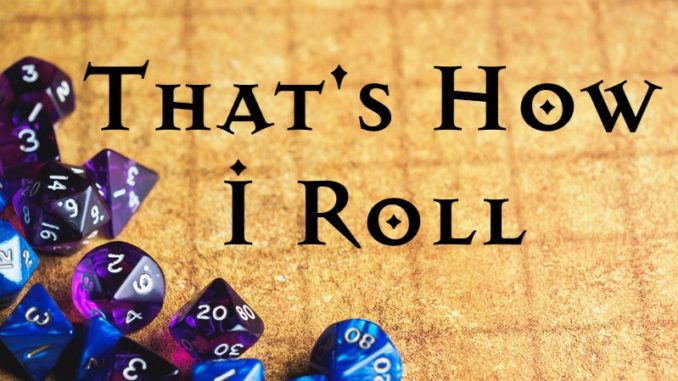
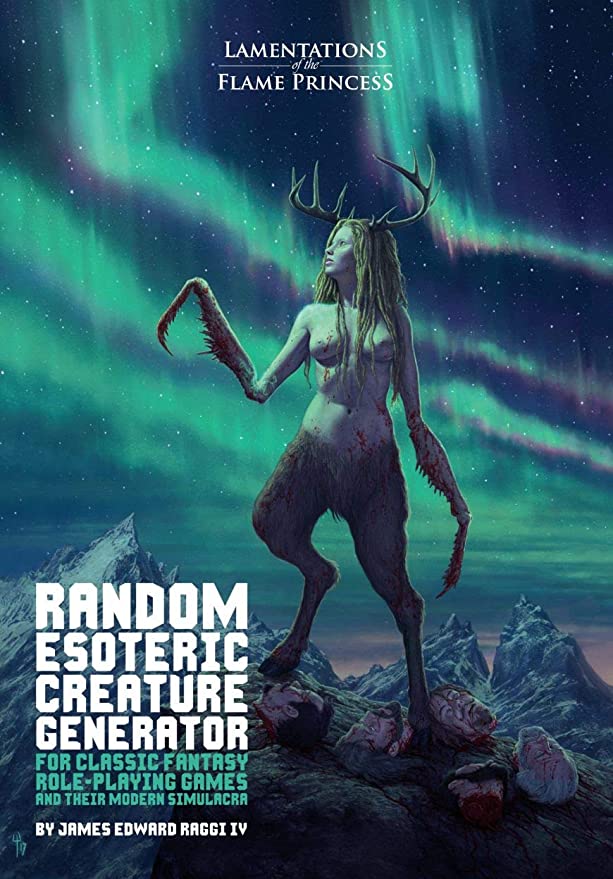 Today I thought I’d have some fun and make a monster using the Random Esoteric Creature Generator (RECG). The RECG is a supplement for LotFP (Lamentations of the Flame Princess, an OSR game), which tends to have a grimdark/weird fantasy tone. Therefore, the results should be delightfully strange and creepy! I’ll walk through the steps of creating a monster using the RECG as I go. I’ll also provide the final stat blocks for both LotFP as well as a 5e conversion, since that will probably be more useful to most readers.
Today I thought I’d have some fun and make a monster using the Random Esoteric Creature Generator (RECG). The RECG is a supplement for LotFP (Lamentations of the Flame Princess, an OSR game), which tends to have a grimdark/weird fantasy tone. Therefore, the results should be delightfully strange and creepy! I’ll walk through the steps of creating a monster using the RECG as I go. I’ll also provide the final stat blocks for both LotFP as well as a 5e conversion, since that will probably be more useful to most readers.
First, our baseline statblock:
- Alignment: The supplement notes that mindless, non-sentient monsters aren’t inherently good or evil, and so should be Neutral (True Neutral) by default unless they aren’t “natural” (i.e. naturally found in nature). In 5e, I think the “Unaligned” option works best, so that will be the baseline.
- AC: All monsters should start with whatever the baseline AC is for that system. For LotFP, that’s 12. For 5e, that’s 10.
- Damage: Using the RECG method, all monsters start with a base damage of 1d6 for all of their attacks. In 5e different types of attacks tend to have different base damages, but let’s just assume 1d6 to make it easier for the conversion.
- HD: The book recommends calculating HD as 1d4-2 + (average character level). If we assume a party of 4 1st level characters (CR 1), then that would bring us to 1d4-1. The average would then be 2 HD, so we’ll start with that as a baseline. In 5e, a standard medium monster conveniently uses a d8 for HP as well. CR 1 monsters in 5e tend to be level 4-5, and since I want the monster to be a little bit more challenging, I’ll go with 5 HD, or 22 HP (5d8).
- XP: The RECG notes that every system has its own XP progression. In LotFP, the main way to gain XP is by recovering treasure, so monsters don’t provide much XP. A monster with 2 HD gives 10 XP, so we’ll start with that as the baseline. For 5e we’ll assume a CR 1 to start, so that will provide us with 200 XP baseline.
- Morale: In LotFP, 1d12 Morale rolls are used to determine whether a foe will stay or flee. The RECG recommends a Morale of 1d8+4, the average of which (rounded up) is 9. So that’s our baseline. For 5e, the optional Morale rules recommend a flat DC 10 Wisdom check, so that will be our baseline.
- Movement: In 5e terms, this is Speed. In LotFP standard, unencumbered movement rates are 120′ per turn when freely exploring/traveling and 40′ per combat round. In 5e, the baseline is 300′ per turn and 30′ in combat, respectively.
- Attacks: Specifically, we’re talking about number of attacks per round. The baseline for both systems is 1 attack per round.
- Number Appearing: We’ll assume that only one of these monsters will appear at a time by default.
- Saving Throws: In LotFP, Saving Throws are the same as a Fighter of equal HD. In LotFP this equates to Paralyze 14, Poison 12, Breath 15, Device 13, and Magic 16; we’ll just use “F1” for short. In 5e Saving Throws are just a d20 check modified by a relevant stat against a particular DC.
- Ability Scores: Monsters generally don’t have ability scores in OSR games, but they certainly do in 5e. I’m going to use a fairly standard array of +2, +2, +1, +1, +0, -1 for the monster, which I will assign after the fact (but will edit into my calculations for the reader’s benefit).
Okay, so we have our baseline monster template. Here’s how it looks:
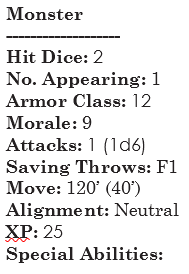
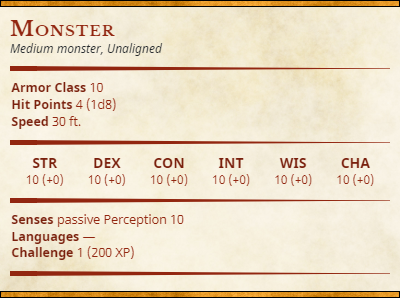
Now that we have our baseline stats, it’s time to do some random generation!
- Basic Body Shape (2d10): Quadruped (14)
- The first random table has to do with the basic body shape of the creature. Is it flat? Bipedal? Serpentine? My result was “Quadruped,” a four-legged creature.
- According to the table, Quadrupeds get a +10′ movement bonus, which will change the Movement/Speed of our monster to 50′ and 40′ respectively.
- Basic Characteristics (2d10): Reptile (9)
- Next we determine the basic characteristics of the monster. What is its basic classification? Avian? Plant? Mammal? I happened to roll “Reptile,” which means that we now have a reptilian quadruped. The next table will tell us exactly what sort of reptile analogue we’re dealing with.
- According to the table, Reptiles have a full maw of sharp teeth, giving it a Bite attack and +1d8 AC due to its tough, scaly hide. The average (rounded up) would be 5, so our monster will now have an AC of 17 in LotFP and 15 in 5e.
- General Type (1d6 for Reptile): Snake (5)
- We know we have a reptilian monster, but exactly which type do we have? For this one I rolled a 5, which correlates to “Snake.” But wait, didn’t we say the monster was a quadruped? We did, and so there are two ways to handle this. Our first option is to roll again on the chart/choose something that fits better. Pretty straightforward. But the second option, which I find to be the most fun, is just rolling with it and trying to adapt the monster as best you can. Yes, snakes generally don’t (never?) have legs, but that doesn’t mean our monster can’t! In fact, a long, windy snake-like quadruped seems pretty creepy – all the better!
- This table doesn’t dictate any particular changes for the general types of monsters. It’s completely up to the GM what if any mechanical changes the monster might undergo due to its type. I have an idea, which you’ll see in the “Movement” step below.
- Size (2d10): Large (11)
- So we have a quadrupedal snake that can tuck in its legs and slither, which is awesome. But how big is it? I rolled on a table and got “Large.”
- According to the table (which, remember, was made with LotFP and other OSR games in mind), Large monsters get +1 HD and upgrade their base attack die one step. In LotFP, this means our monster has 3 HD and a 1d8 bite attack. For 5e, Large creatures use 1d10 HD, so our creature now has 38 HP (5d10+10) and a 2d8+2 bite attack.
- Movement (2d10): Standard (9)
- The movement table describes how the monster moves. Usually you can figure out at least one type of movement the monster can do just from its basic characteristics. I happened to roll “Standard” which means whatever the regular type of movement of monster of its characteristics/type would do.
- The table doesn’t list any mechanical changes for Standard movement. In our case, quadrupeds (even snake-like ones) ostensibly walk. However, since our quadruped is snake-like, I think it would be really bad-ass and creepy if our monster could tuck in its legs and slither like a normal snake; I like the idea so much that I’m going to give it that movement option. Since we only received a movement bonus for its quadrupedal nature, I’ll just say that it moves a standard 40’/30′ when slithering – maybe it slithers in order to stay low and stalk its prey!
- Attack Methods (1d10): Spikes/Horns (8)
- This table gives us the method(s) our monster uses to attack its foes. We already know it has a bite from the fact that it’s reptilian. We could just leave it at that, but that’s no fun! Instead, I decided to roll to see what else (if anything) our monster could use to attack, and got “Spikes/Horns.” That sound pretty awesome, so why don’t we say that our monster’s tail is covered in spikes, and give it a Tail Attack that does piercing damage?
- According to the table, the spikes/horns attack should get a +1 step bonus to its damage die, so our Tail Attack will do 1d10 damage in LotFP and 2d10+2 Damage in 5e.
- Distinctive Features (d100): Rubbery Body (56)
- The Distinctive Features table gives us cool little idiosyncrasies to make our monsters more unique. I rolled “Rubbery Body,” which could actually make a lot of sense for a snake-like monster.
- According to the table, having a Rubbery Body means that any attack that does less than half of its possible damage (ex. 1-3 on a d6) will harmlessly bounce off the creature, doing no damage. Moreover, missile attacks have a 10% chance of hitting another random combatant in range, and if so, the original makes new to-hit and damage rolls against the new target.
- Special Abilities (2d100): Charm (91)
- The Special Abilities table gives our monster at least one unique ability in addition to their other characteristics and attacks. For this one, I rolled Charm (how perfect is that?!).
- According to the table, Charm allows the monster to take a special action to try to control an opponent. The opponent must make a saving throw or fall under the monster’s control. When under the monster’s control, the opponent will either defend the monster/attack one of the monster’s foes; or do nothing and become an easy target for the monster. A new saving throw can be made each round to shake off the monster’s control. For 5e, I’m going to treat this ability like Charm Person, and use the spellcasting saving throw guidelines from the DMG. Therefore, resisting the monster’s Charm requires making a DC 11 saving throw against the opponent’s WIS, and the ability has a range of 30′.
- Delivery of Special Attacks (2d10): Projectile (9)
- The Deliver of Special Attacks table lets us know how the monster delivers attacks with its special ability (when applicable). I rolled “Projectile.”
- A “Projectile” delivery means that the monster’s Charm ability will requires a ranged attack to see if the ability “hits.” Perhaps this could be narratively described as the monster trying to meet the gaze of an opponent. Since 5e has guidelines for magic attacks, I’ll use those; the monster has a +3 attack bonus with its Charm ability, and a 30′ range as already established.
- Combat Tactics (1d10): Non-Humans (10)
- Combat Tactics refer to the way in which the monsters chooses its targets. Does it go for the closest opponent? Is it random? Do they sense magic and so go after spellcasters? I rolled “Non-Humans.”
- According to the table, monsters with combat tactics targeted at non-humans will go after demi-humans and other humanoids whenever such targets are available. Of course, you might very well find this to be unfair, especially if the party only has a small number of non-humans. If that’s the case, feel free to use a different combat tactic, like the closest opponent.
- Motivation (1d10): Territorial (10)
- Last but not least, the Motivation table answers the question of what drives the monster’s behavior, and especially why it would attack an adventuring party. For this final item, I rolled “Territorial.”
- According to the table, territorial creatures seek to defend their homes and lairs against intruders. The monster will pursue enemies beyond the boundaries of its territory.
Here’s what we’ve ended up with:
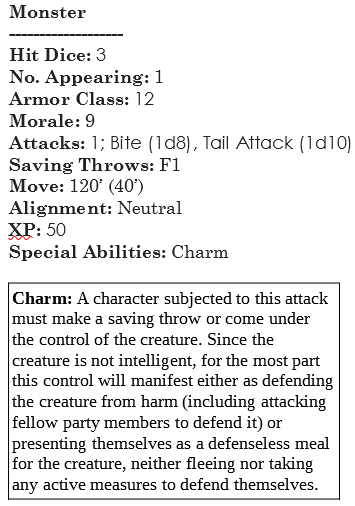
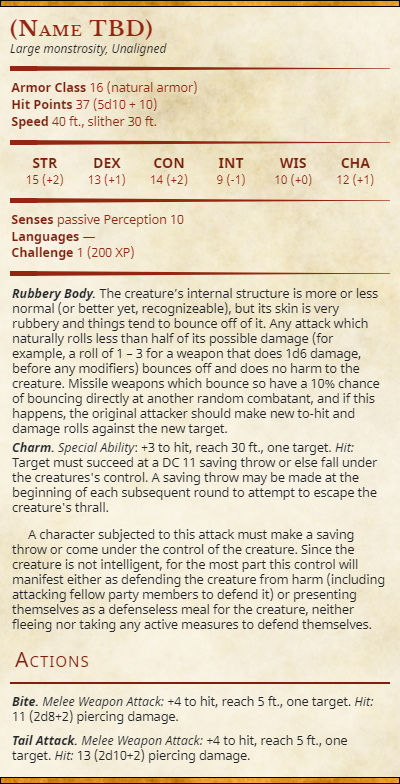
You may have noticed that something’s missing – a name! I thought it would be fun to leave that up to the readers. So, if you have any ideas for a good name for this creature, leave a comment below, and feel free to call out your favorites! See you next week.
Special Thanks to Eric Strimple for assisting with the 5e conversion!
Do you have thoughts or questions about the article or suggestions for future content? Leave a comment below or drop me a line at jtdimino@d20radio.com.
